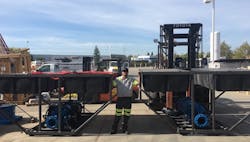About the author:
Cristina Tuser is associate editor for iWWD. Tuser can be reached at [email protected] or 847. 391.1007.
|
Location Yosemite Valley, Calif. Project Size 310 ft of head; 1,150 gpm Cost Not specified Facility Owner San Francisco Public Utilities Commission Project Owner San Francisco Public Utilities Commission Designer HERC Pro Solutions Contractor Anvil Builders Manufacturer Tsurumi Pump Equipment Three 150hp submersible pumps |
Cherry Dam on the border of Yosemite Valley, Calif., needed to remove and replace two 66-in. hollow-jet valves. For this replacement to be completed safely, the reservoir had to be drained below the intake tower so no water flowed through the dam during removal and replacement.
Pumped water needed to be diverted over the damn to keep the site of the butterfly valves clear to perform the repair work. The main challenge was to provide a pumping system capable of maintaining 5 cu ft per second of water up and over the dam (310 ft from low lake level to the top of the dam). The pumps needed to work constantly throughout the months-long duration of the project to keep water running for fish and wildlife.
“The most significant obstacle was the initial static head requirement. 300 vertical ft to get up and over the dam,” said Patrick LaZansky of Herc Rentals Inc. “With this much vertical head, most rental companies would utilize diesel, driven-end suction centrifugal pumps. This type of pump would not be suitable because of placement—water level could lower and rise over duration of project—and also because having diesel fuel and engine oil close to a pristine body of water is a significant environmental risk.”
Drinking water from Cherry Dam also is supplied to the Greater San Francisco Bay Area, so a diesel pump would not suffice, as running diesel engines near a drinking water source negatively impacts the water quality.
The system worked flawlessly, even through sub-freezing winter months, high up in the mountains.
“The most important goal was to maintain critical flows in the creek downstream to provide enough water for fish and other wildlife to survive. Secondly, keeping lake levels down, it provided a safe working environment for Anvil Builder’s crews and divers to work on the powerhouse,” said LaZansky.

